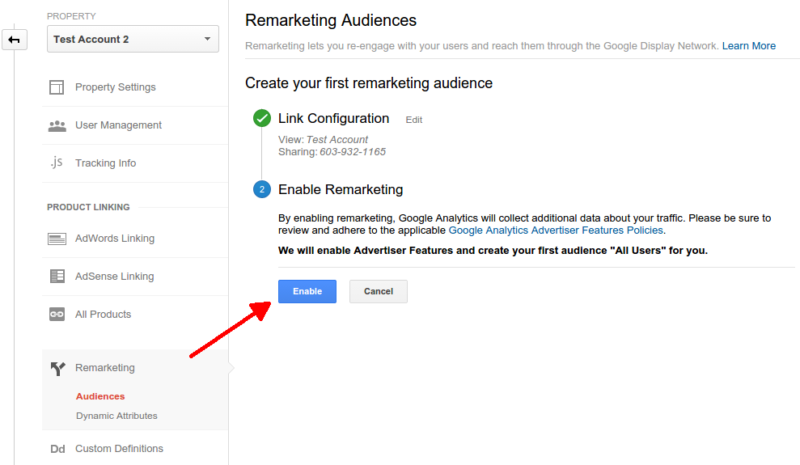Reliable Approaches for Remarketing In Google Analytics
Reliable Approaches for Remarketing In Google Analytics
Blog Article
Maximize Your ROI With Remarketing in Google Analytics
By harnessing the power of user information and customizing advertisements to details audience sections, services can dramatically intensify their conversion prices. The trip to optimizing ROI with remarketing is a nuanced path led with insights and opportunities that can reshape the trajectory of your advertising and marketing undertakings.
Recognizing Remarketing in Google Analytics
Comprehending remarketing in Google Analytics is vital for enhancing your electronic advertising strategy. Remarketing allows you to target users who have formerly seen your internet site or engaged with your app, offering them with customized ads as they browse various other sites or use other applications within the Google Present Network. This technique helps keep your brand name top of mind and encourages individuals to return to your website, eventually boosting the chance of conversion.
By utilizing Google Analytics, you can track the performance of your remarketing campaigns, gaining beneficial understandings into user behavior, engagement, and conversions. This data allows you to fine-tune your bidding process, targeting, and messaging strategies to boost the overall efficiency of your projects.
In addition, recognizing the various sorts of remarketing checklists readily available in Google Analytics, such as conventional, vibrant, and comparable target markets, enables you to create individualized and highly segmented campaigns customized to details customer sections. This level of granularity can dramatically improve the relevance and impact of your remarketing initiatives, ultimately optimizing your return on financial investment.
Establishing Remarketing Lists
To efficiently carry out remarketing projects in Google Analytics, the initial action includes creating and setting up remarketing checklists targeting certain individual sectors based on their interactions with your web site or application. By establishing remarketing lists, you can tailor your advertising efforts to reach users who have actually already shown passion in your services or items.
To begin, browse to the Admin section of your Google Analytics account and select the Property where you desire to develop the remarketing checklist. Under the Property column, click on 'Audience Definitions' and pick 'Target markets.' Next, click the red 'New Target market' button and choose 'Create New' to specify the specifications for your remarketing checklist.

Crafting Reliable Remarketing Ads

When crafting your ads, emphasis on developing eye-catching headings and compelling visuals that stick out to potential clients. Integrate strong calls-to-action that motivate individuals to review your website and finish a preferred activity. Utilize dynamic remarketing to reveal tailored ads featuring services or products that users have previously seen on your website.
Additionally, make sure that your advertisements are mobile-friendly given that a significant part of net web traffic originates from mobile phones. Test various ad variants to determine which styles and messages drive the most effective outcomes. By constantly refining and enhancing your remarketing ads based upon efficiency data, you can optimize their effectiveness and boost your important source roi.
Analyzing Remarketing Efficiency

With Google Analytics, online marketers can track the efficiency of their remarketing projects in real-time, enabling them to identify patterns, patterns, this contact form and areas for renovation without delay. By evaluating the data, marketing experts can establish which ads are performing well, which audience sections are responding positively, and which channels are driving the most conversions. This degree of granularity allows marketing experts to make data-driven choices to maximize their remarketing advocate better results.
Optimizing ROI With Remarketing
Evaluating remarketing information in Google Analytics allows marketing professionals to determine possibilities for maximizing roi (ROI) with tactical modifications - What Is “Remarketing” In Google Analytics?. To take full click for info advantage of ROI with remarketing, it is essential to understand the behavior of your audience. By analyzing user interactions, such as the pages they saw, the items they checked out, or the actions they took on your website, you can tailor your remarketing projects better
Segmenting your target market based upon their actions enables you to produce tailored and targeted advertisements that are extra most likely to resonate with them. By revealing relevant advertisements to specific sectors of your audience, you can boost the possibilities of conversion and ultimately improve your ROI.
Furthermore, checking different ad creatives, messaging, and offers can help recognize what resonates best with your target market. A/B testing enables you to experiment with various components of your advertisements to determine what drives the greatest interaction and conversion rates.
Final Thought
In conclusion, making best use of ROI with remarketing in Google Analytics requires a critical method to assessing individual actions, segmenting audiences, producing customized advertisements, and optimizing project performance. By leveraging data-driven understandings and testing different methods, businesses can enhance their remarketing initiatives to drive greater involvement and conversion rates. This methodical approach makes sure that sources are successfully assigned in the direction of making the most of returns on financial investment in remarketing projects.
Next off, click on the red 'New Audience' button and select 'Produce New' to define the parameters for your remarketing listing.
By continuously refining and enhancing your remarketing advertisements based on performance information, you can maximize their efficiency and boost your return on financial investment.
By delving into these insights, marketers can acquire a thorough understanding of exactly how their remarketing initiatives are resonating with their target audience and driving conversions. To make the most of ROI with remarketing, it is vital to recognize the behavior of your target market.In verdict, making the most of ROI with remarketing in Google Analytics requires a calculated strategy to analyzing customer habits, segmenting audiences, producing tailored ads, and enhancing campaign performance.
Report this page